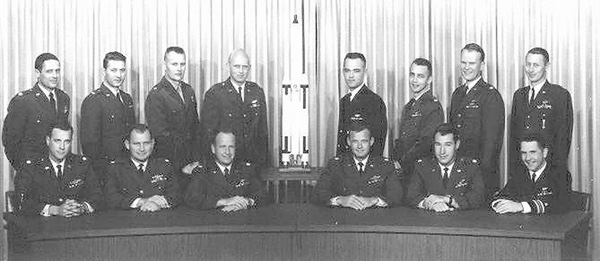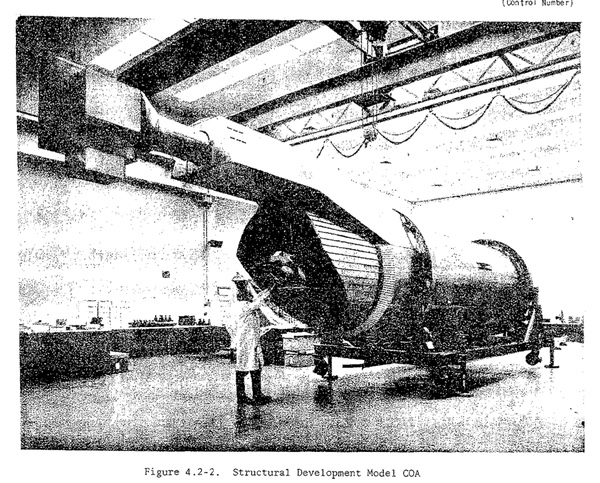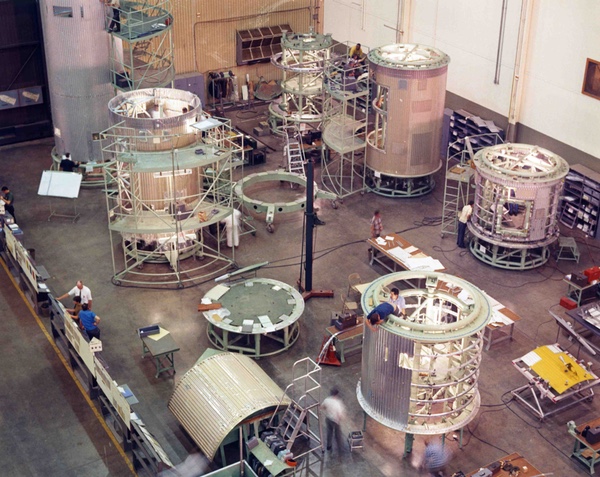Blue suits in polar orbits: the MOL astronauts (part 1)by Dwayne Day
|
| Truly was amazed. He hadn’t known that all of this stuff existed. And now he was going to be part of a program that did it. |
But what happened the next day was even more memorable. Saturday morning, the MOL astronaut candidates reported to the Space and Missile Systems Office at Los Angeles Air Force Base, only a few miles from Los Angeles International Airport (LAX). That’s when the briefings began.
The eight men were told that the public story about MOL—that it was intended to evaluate what military missions astronauts could perform in space—was a cover story. What MOL was really supposed to do was to take high-resolution reconnaissance photographs of the Soviet Union. And that’s when Truly and his fellow MOL astronauts were briefed on America’s top secret reconnaissance satellite programs. They were told about CORONA, which took broad area photographs of large amounts of territory in order to find new targets and keep track of existing ones. And they were told about GAMBIT, which could take high-resolution images of targets such as ICBM sites and submarine bases. Truly was amazed. He hadn’t known that all of this stuff existed. And now he was going to be part of a program that did it.
The National Reconnaissance Office (NRO) began declassifying information on the MOL program in 2012, including schematics of what the inside of the spacecraft looked like as well as details of its powerful optical system, even going so far as to reveal that the optical system was called “Dorian.” The NRO has also released programmatic details on MOL’s history, such as the fact that it ended up in competition with the large HEXAGON search satellite that was also under development in the latter 1960s. HEXAGON was initially canceled in early 1969, but after the Director of Central Intelligence personally appealed to Richard Nixon, HEXAGON was restored and MOL was given the axe on June 10, 1969. Thousands of workers, particularly in southern California, lost their jobs overnight. After that, MOL faded into obscurity.
Now MOL is being remembered. The NRO has begun releasing documents on the MOL program, including an official history that focuses more on the management details than the technology, and does not mention the astronauts at all. But the remaining astronauts can now also start to tell their stories of what they did for that period of just under four years in the latter 1960s. This week there will be even more revelations.
Robert Crippen remembers having had a similar experience to Truly in June 1966, when the five members of the second group of MOL astronauts were named. There was no press conference this time, but Crippen also received an extensive briefing about reconnaissance satellite capabilities, and he too was really impressed. When asked what he thought of it, Crippen used a fighter pilot’s term: “Shit hot!” he said, grinning.
Ultimately, the Air Force named seventeen astronauts in three groups. They were a mix of mostly Air Force with some Navy pilots, like Crippen and Truly, and one Marine. They all had test pilot experience. Robert Lawrence was going to be the first African American astronaut.
 Fourteen of the seventeen astronauts selected for the MOL program. Top row, from left: Herres, Hartsfield, Overmyer, Fullerton, Crippen, Peterson, Bobko, Abrahamson. Bottom row, from left: Macleay, Lawyer, Taylor, Crews, Neubeck, Truly. |
MOL consisted of a Gemini spacecraft in front of a long laboratory module made of both pressurized and unpressurized compartments. The pressurized compartment contained the living quarters and the equipment for operating the spacecraft systems and the unpressurized compartment contained the optical system. According to Truly and Crippen, the MOL astronauts’ job was to run MOL’s powerful camera system designated DORIAN—usually spelled in all caps—and consisting of a 72-inch (1.8-meter) diameter primary mirror in an unpressurized compartment that focused images into a camera that was mounted inside the pressurized compartment with the astronauts. Film would slide through the camera and get exposed, then wound up on a takeup reel. The astronauts could remove the film and place it in one of several return capsules that could be ejected from MOL and would reenter Earth’s atmosphere to be recovered. They would also bring film back with them in their Gemini spacecraft. When asked where they would fit the film in the already-cramped capsule, both Truly and Crippen smiled. “Wherever we could!” Truly laughed.
| When asked where they would fit the film in the already-cramped capsule, both Truly and Crippen smiled. “Wherever we could!” Truly laughed. |
Truly and Crippen explained that their job was to look through periscopes that peered out the side of the spacecraft toward the Earth, slightly ahead of the spacecraft’s ground track. MOL had a sophisticated computer system that included the targets that MOL was going to fly over. The astronauts would look at the targets before the spacecraft flew over them and determine if they were free of clouds and revealed anything useful, and then prioritize them for the computer. For instance, a Soviet launch pad free of cloud cover might be a medium priority target, but if there was a missile on the pad it would be high priority and they would tell the computer to treat it as such.
Once the data was in the computer it was the computer and not the astronauts who controlled the big camera system. It would rotate and point toward the highest priority targets and snap their photos. The computer could essentially recalculate on the fly, dropping lower priority targets if they conflicted with higher priority targets. The computer was still in development in the late 1960s, but Truly thought it was an impressive piece of equipment.
But that was the astronauts’ job in orbit. When the three astronaut groups were announced—in November 1965, June 1966, and June 1967—their initial role was to provide program oversight. They did not train for missions, but instead represented the MOL astronaut office to all the different contractors involved in producing the large and complex spacecraft. They still maintained their flight status and were assigned a few old airplanes at nearby LAX that they could use to fly around the country.
Donald Peterson, another MOL astronaut, gave an interview to a NASA historian in 2002 and told how he used to travel with Robert Lawrence, whom he liked a lot. “The rest of us were unknown, and we could travel on false ID, and nobody knew, had any idea who I was. But they worried because the press learned to recognize him. In other words, they knew him on sight, and it becomes much harder to run a secret program when one of your guys is, like, a high interest to the media, and he really was for a while,” Peterson remembered. “He kind of shunned that, obviously to try to shut some of that down. We always worried that we’d show up at some place and somebody would recognize him and make a big to-do about it.” Lawrence was killed in a training accident in December 1967. “His death was a terrible tragedy,” Peterson recalled. But it was not unique—Lawrence died less than a month after another MOL astronaut, Michael J. Adams, was killed in an X-15 accident.
As the astronauts traveled around the country meeting with contractors during the latter half of the 1960s, they were aware that the program was running into delays and cost overruns, and the date when they would actually start flying was slipping. Crippen and Truly believe that MOL ran into problems for the standard reasons that many big space programs run into problems—it did not receive the money it needed when it needed it and important tasks were put off, stretching out the schedule and costing more money in the long run.
 Structural model of the large DORIAN optical system for the Manned Orbiting Laboratory program. The camera for recording images on the film is located at upper left and would have been accessible to the astronauts inside the pressurized compartment. |
Al Crews was a member of the first group of MOL astronauts along with Richard Truly. He sat down for an interview in his Florida home in January. Crews said that visiting the contractor facilities made him doubt the program’s chances. “They were spending a lot of money on facilities,” he said. It seemed to him that the contractors were building a lot of new buildings and he wondered how much of their money was actually going into the spaceflight hardware. By 1967–68, MOL was behind schedule and over budget—and gaining some important critics inside the intelligence community.
| By 1968 MOL was running into a lot of opposition within the highest levels of the intelligence community. All of this was happening thousands of miles away from the astronauts in their program office in Los Angeles, and they were unaware of the gathering storm in Washington. |
Crews also said that he remembered becoming really skeptical that MOL would continue when one day the astronauts were shown reconnaissance imagery from one of the latest GAMBIT missions. The imagery was so sharp that it was essentially the equivalent of what MOL was supposed to do, several years later and at much greater expense. At that point he wondered why they needed astronauts to do what the machines were already doing.
Crews’ skepticism was warranted, because by 1968 MOL was running into a lot of opposition within the highest levels of the intelligence community. People in the CIA—MOL was considered to be primarily an Air Force program—were wondering what MOL could do that was worth the cost. And scientific advisers were questioning the value of humans to control a sophisticated optical system in orbit. The contractors had been told to develop a version of MOL that could operate without a crew. All of this was happening thousands of miles away from the astronauts in their program office in Los Angeles, and they were unaware of the gathering storm in Washington.
